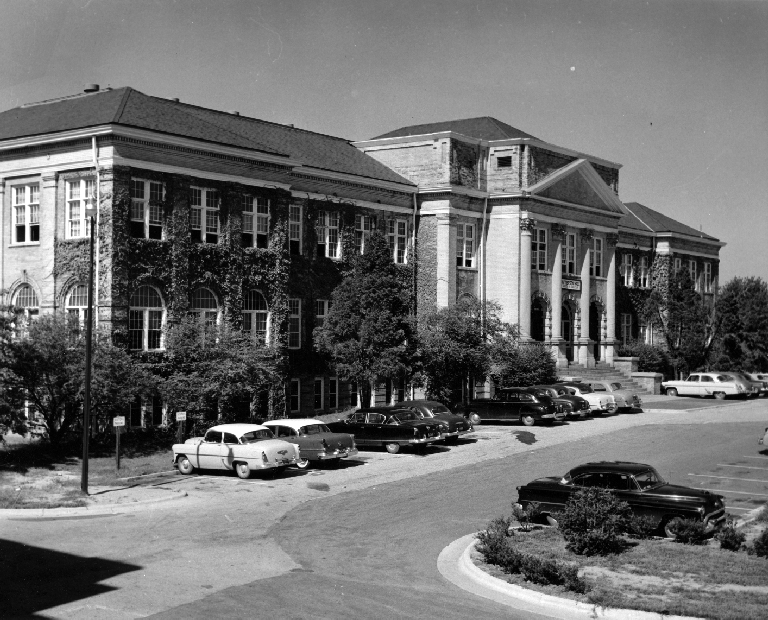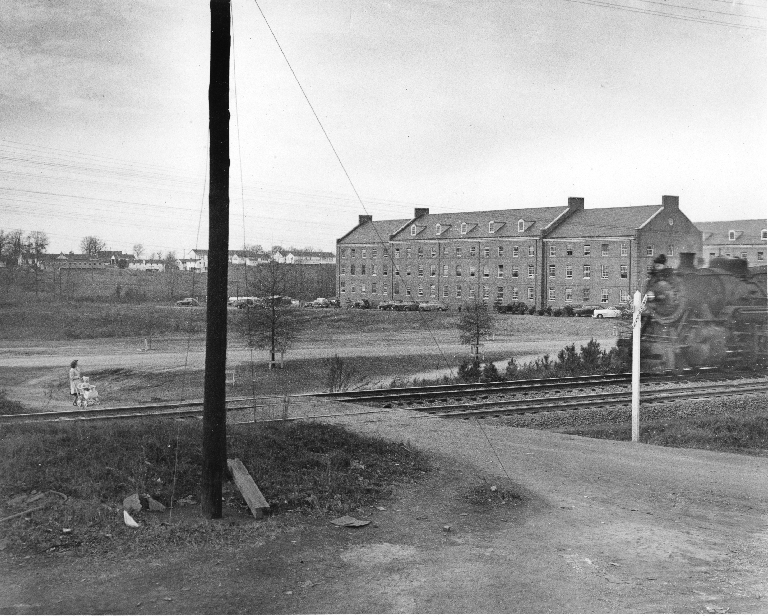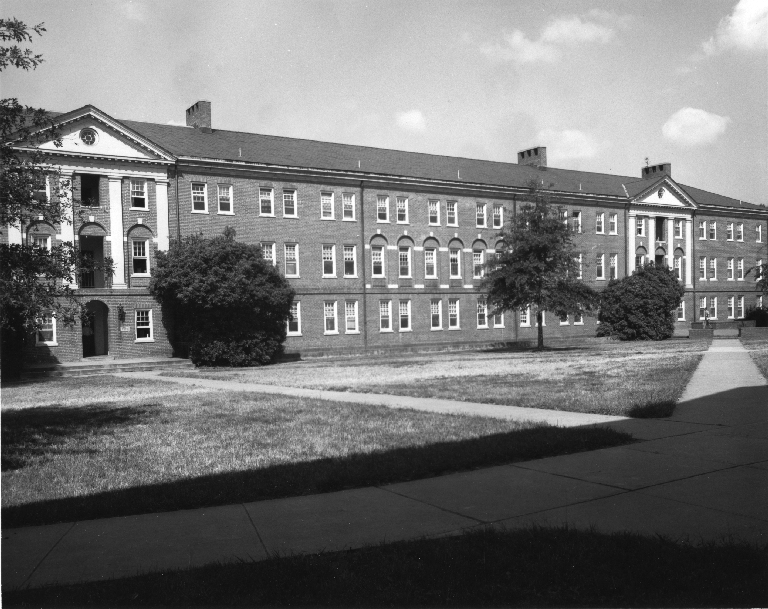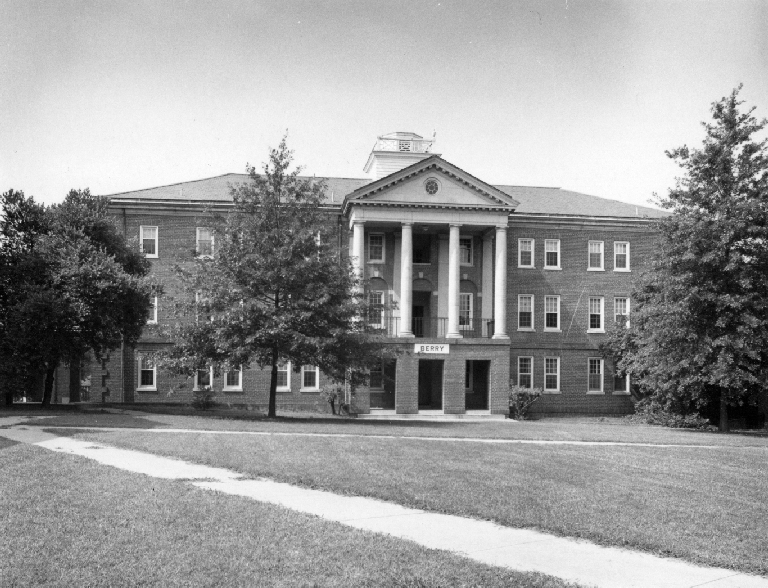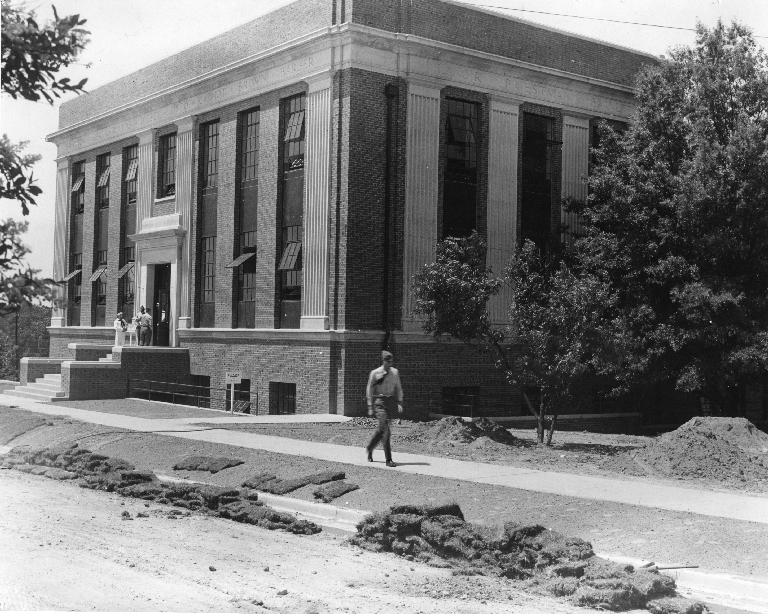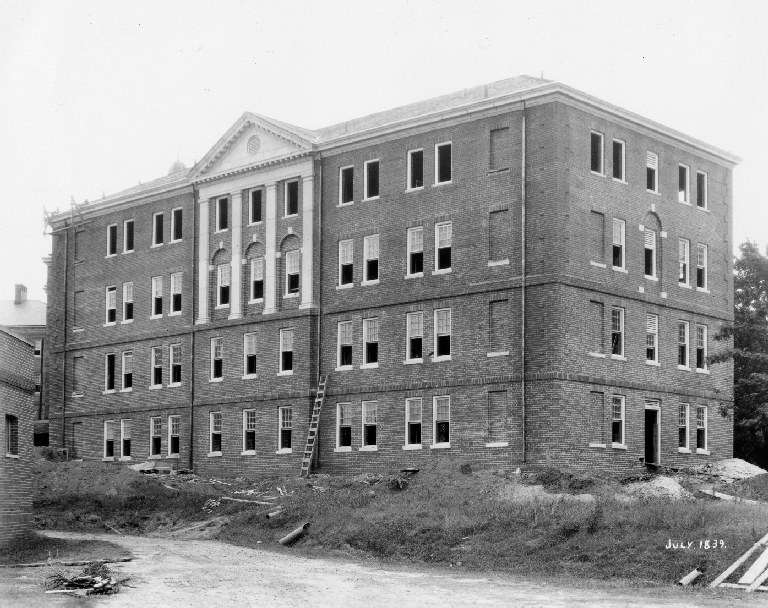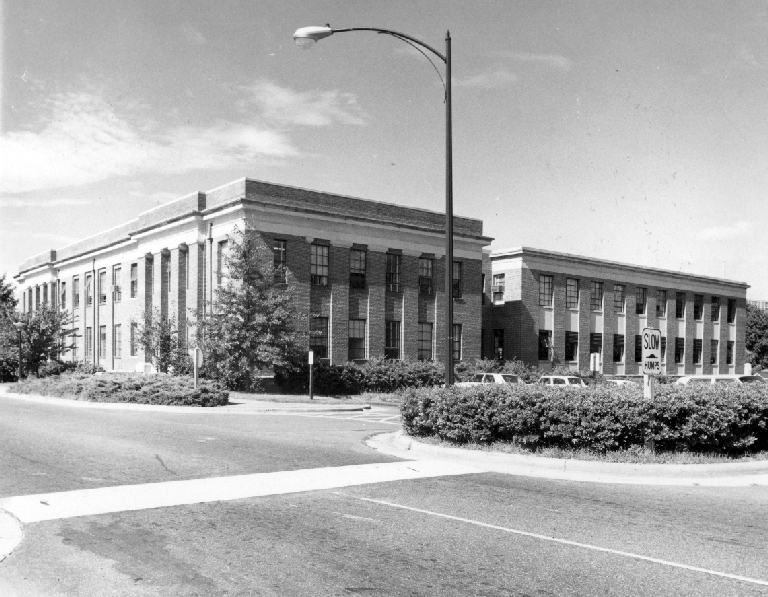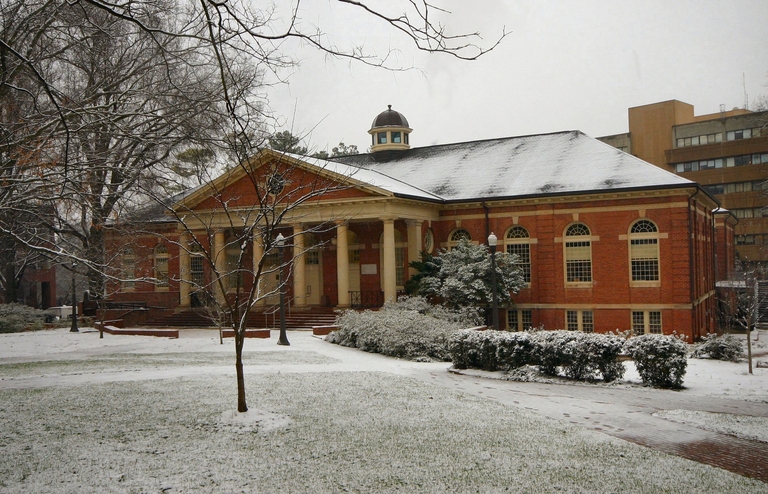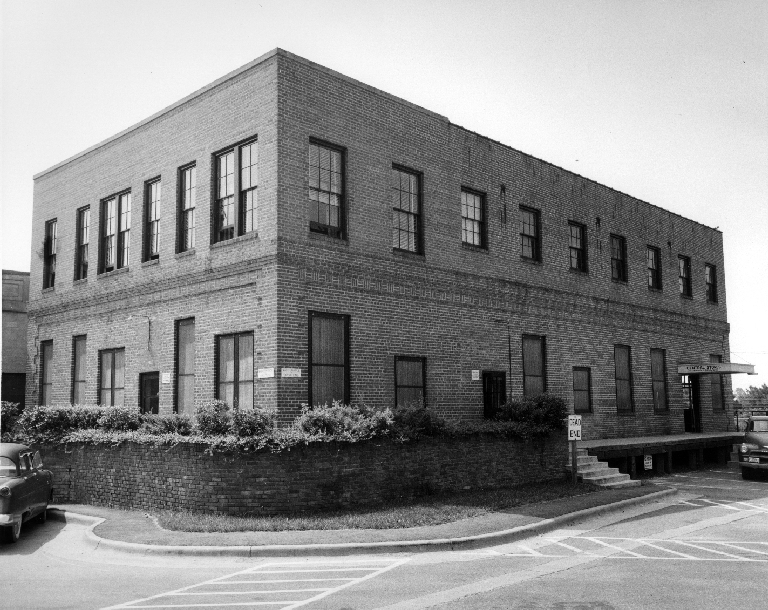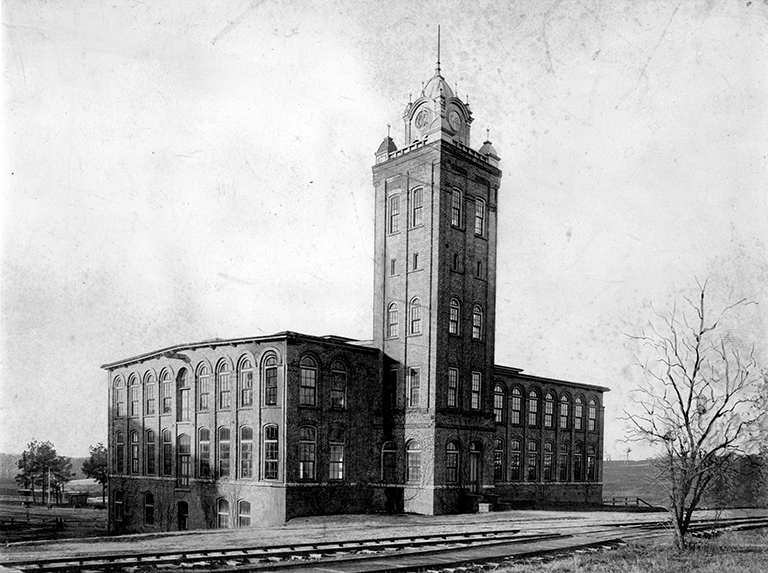Shumaker, Ross Edward (1889-1960)
Variant Name(s):
Ross Shumaker
Birthplace:
Gladdens, Pennsylvania, USA
Residences:
- Beckley, West Virginia
- Raleigh, North Carolina
Trades:
- Architect
NC Work Locations:
Building Types:
Styles & Forms:
Beaux-Arts; Colonial Revival; Modernist
Ross Edward Shumaker (1889-1960) was born in Gladdens, Pennsylvania on January 31, 1889. He received an undergraduate degree in architecture from Ohio State University in 1916 and completed graduate study at Pennsylvania State University and Harvard University. He served as instructor of architecture at Pennsylvania State University in 1916 and 1919 and worked as an architect in Beckley, West Virginia in 1917 and 1918.
Shumaker came to North Carolina State University, then called North Carolina State College of Agriculture and Engineering and popularly referred to as State College, on January 20, 1920, to become professor of architecture in the Engineering Department. At the time, architecture studies at State College fell under the Engineering Department. Shumaker advocated for the creation of a separate department, and in 1923 the college began a degree program in architectural engineering and appointed Shumaker as the head of the Department of Architecture. Popular among the students, Shumaker served as the sole full professor until Jehu DeWitt Paulson joined as second professor in 1926. The two led the department for the next twenty-two years.
Shumaker shaped the curriculum around classical architecture and the Beaux-Arts approach to design. His attention to “exercises in designing” led his students to be highly successful in Beaux-Arts competitions. By the late 1930s, however, he was introducing modernist styles of design and modern materials into his curriculum. Into the mid-1940s, Shumaker continued to head the department, which comprised Paulson, two assistant professors, and six instructors, many of whom were Shumaker’s own graduates. By this time, a division in the department had occurred between architecture and architectural engineering.
This division, coupled with advancements in science and technology and pressure from the National Architectural Accrediting Board pushed State College to modernize its architecture program, and in 1946 the School of Architecture and Landscape Design was established. It opened its doors to students two years later.
Henry Kamphoefner, a forty-one year old modernist architect and professor from the University of Oklahoma, arrived as founding dean in 1948. Kamphoefner, who renamed the program the School of Design, believed the Beaux-Arts approach to be oppressive and outdated and brought to State College a modernist agenda and the plan to replace nearly the entire architectural engineering faculty. Kamphoefner retained Shumaker and one other associate professor, William L. Baumgarten, as faculty, while Paulson and nine others were terminated. During this restructuring, the budget nearly doubled from Shumaker’s proposed $69,000 in 1947 to Kamphoefner’s $108,000 in 1948 to support the new school and faculty. Shumaker continued as a professor until 1956.
In addition to his teaching duties, Shumaker also served as College Architect for many years. He worked in the 1920s on campus projects designed by New York architect Hobart Upjohn and independently designed Morris Hall in 1926. In 1939 he led a $1,600,000 building program sponsored by the Works Progress Administration (WPA). In a four-year flurry of design and building activity, Shumaker with his chief draftsman, Jesse M. Page, drew plans and superintended construction of eight campus buildings: Alexander Hall, Becton Hall, Berry Hall, both with Upjohn, and Turlington Hall, the David Clark Laboratories, Clark Hall, a Dairy Plant and the remodeling of the Diesel Wing of Broughton Hall. He also planned the Tompkins Hall renovation in 1939, the Riddick Field Field House in 1938, and a Laundry Facility in 1940, and saw to the remodeling of the Agriculture Building and the Chancellor’s Residence’s kitchen. Not far from the campus, in 1941 he also designed the Levine Home for Mr. and Mrs. Jack Levine.
For one important project at North Carolina State University—Reynolds Coliseum—some sources have claimed a role for Shumaker in the design, but no primary documentation of the coliseum’s architect or architects has been found. The building was initially conceived in the mid-1930s as a coliseum and armory; a fundraising campaign and WPA funds permitted purchase of the structural steel; and a donation from Mary Reynolds Babcock enabled construction to begin. After a delay because of World War II, the $2 million coliseum was completed in 1949.
Beyond Raleigh, Shumaker also designed campus buildings for the University of North Carolina at Pembroke, then called Pembroke State College for Indians, in Pembroke, North Carolina, as well as for University of North Carolina at Asheville. For the small campus at Pembroke, he designed the Library and Administration Building and the Science and Agriculture Building in 1948, the Arts Building in 1949, and the President’s Home in 1950. It is likely that he also designed a gymnasium around the same time, which received additions and renovations in July of 1952. These buildings were most likely replaced during Pembroke’s campus expansion and renovation in the 1970s. In Asheville, he designed a Minerals Research Laboratory in 1945.
Shumaker became professor emeritus of architecture at State College in 1956 and remained active in the profession until his death. He became a member of the North Carolina chapter of the American Institute of Architects in 1940 and he served as vice president of the chapter in 1945, president in 1946, executive secretary from 1952 to 1954, and regional director from 1948 to 1951. In 1955 he received the honor for outstanding service to the chapter and became one of six members emeritus in 1957. From 1932 to his death in 1960 he served as an officer and Executive Secretary of the North Carolina Architectural Registration Board and sat on that board. Keenly interested in both the history and the future of architecture, Shumaker was a charter member of the Society of Architectural Historians and the Society of Architectural Examiners. Shumaker died in Raleigh’s Rex Hospital on April 8, 1960 after a lengthy illness. He was survived by his wife Mozelle Shumaker and four daughters.
- Burton F. Beers and Murray Scott Downs, North Carolina State University: A Pictorial History (1986).
- David Louis Sterrett Brook, “Henry Leveke Kamphoefner, the Modernist, Dean of the North Carolina State University School of Design, 1948-1972,” Ed.D. dissertation, North Carolina State University (2005).
- Craig Chappelow, Raleigh’s Reynolds Coliseum (2002).
- Guide to the Harvey Charlton Papers, Special Collections Research Center, North Carolina State University Libraries, Raleigh, North Carolina.
- Department of Administration State Construction Office, Construction Contracts File, North Carolina State College of Agriculture and Engineering, North Carolina State Archives, Raleigh, North Carolina.
- Historical State: History in Black and White, http://historicalstate.lib.ncsu.edu.
- News and Observer, “Eighth Dormitory Groundbreaking,” Chancellor’s Office, University Archives, North Carolina State University Libraries, Raleigh, North Carolina.
- North Carolina State University Archives Reference Collection, UA50.3, Biographical Files, 1889-2009, Special Collections Research Center, North Carolina State University, Raleigh, North Carolina.
- “Ross E. Shumaker, 1889-1960,” The Southern Architect (1960).
- University Buildings, Building Costs, 1956-1990, Compilation of Buildings, Special Collections Research Center, North Carolina State University, Raleigh, North Carolina.
Agriculture Building
Contributors:William Carter Bain, contractor (1903-1905); C. C. Hook, architect (1903-1905); Hook and Sawyer, architects (1903-1905); Ross Edward Shumaker, architect (1930 and 1940); Hobart Upjohn, architect (1924)Variant Name(s):Patterson Hall
Dates:1903-1905; 1924 [renovated]; 1930 [renovated]; 1940 [renovated]
Location:Raleigh, Wake CountyStreet Address:North Carolina State University Campus, Raleigh, NC
Status:Standing
Type:Educational
Images Published In:Marguerite E. Schumann, Strolling at State: A Walking Guide to North Carolina State University (1973).
Note:The Manufacturers’ Record (July 21, 1904) announced that S. L. Patterson, commissioner of agriculture, was to open bids on August 2nd for construction of the agriculture building for the N. C. College of Agriculture and Mechanic Arts. Potential bidders could view plans at the commissioner’s office or “at the office of Hook and Sawyer, architects, Charlotte, Greensboro, Raleigh.” This is a recent link with the architects for this prominent building at the university. Patterson Hall is said to have been modeled after the agriculture building at Ohio State University.
Alexander Hall
Contributors:Jesse M. Page, draftsman; Ross Edward Shumaker, architectDates:1939
Location:Raleigh, Wake CountyStreet Address:North Carolina State University Campus, Raleigh, NC
Status:Standing
Type:Educational
Note:Alexander Hall was one of five dormitories built with financial support from the Public Works Administration to alleviate a shortage of dormitory space at NC State. It was renovated in 1990.
Arts Building
Contributors:Ross Edward Shumaker, architectDates:1949
Location:Pembroke, Robeson CountyStreet Address:University of North Carolina at Pembroke Campus, Pembroke, NC
Status:No longer standing
Type:Educational
Becton Hall
Contributors:Dates:1939
Location:Raleigh, Wake CountyStreet Address:North Carolina State University Campus, Raleigh, NC
Status:Standing
Type:Educational
Note:Becton Hall, together with Berry Hall, the earlier Bagwell Hall (1925, see Hobart Upjohn) and the Honors Village Commons Building (2005), forms the Honors Village on the North Carolina State University campus. Its construction was financed by the Public Works Administration after the Great Depression.
Berry Hall
Contributors:Dates:1939
Location:Raleigh, Wake CountyStreet Address:North Carolina State University Campus, Raleigh, NC
Status:Standing
Type:Educational
Note:Berry Hall, together with Becton Hall, the earlier Bagwell Hall (1925, see Hobart Upjohn) and the Honors Village Commons Building (2005), forms the Honors Village on the North Carolina State University campus. Its construction was financed by the Public Works Administration after the Great Depression.
Broughton Hall
Contributors:Jesse M. Page, draftsman (1944); Ross Edward Shumaker, architect (1944)Dates:1944; 1951
Location:Raleigh, Wake CountyStreet Address:North Carolina State University Campus, Raleigh, NC
Status:Standing
Type:Educational
Note:Broughton Hall (built in 1951) incorporates the older Diesel School (1944), the construction of which was financed by state emergency funds appropriated by governor, later U.S. Senator, Joseph Melville Broughton. It was used to house the Navy’s diesel engine training program during World War II. A large fountain, located at the current location of Gardner Arboretum and the Burlington Engineering Laboratories, was actually the cooling radiator for the engines housed in the Diesel School. The photograph shows Diesel School before the construction of Broughton Hall.
Clark Hall
Contributors:Jesse M. Page, draftsman; Ross Edward Shumaker, architectVariant Name(s):Clark Infirmary
Dates:1939
Location:Raleigh, Wake CountyStreet Address:North Carolina State University Campus, Raleigh, NC
Status:Standing
Type:Educational
Note:Originally built as a dormitory in 1939 with financial support from the Public Works Administration and renovated in 1981 and 2002, Clark Hall was the home of the university’s Student Health Service until 1992.
Dairy Plant
Contributors:Jesse M. Page, draftsman; Ross Edward Shumaker, architectDates:1939
Location:Raleigh, Wake CountyStreet Address:North Carolina State University Campus, Raleigh, NC
Status:Unknown
Type:Educational
David Clark Laboratories
Contributors:Jesse M. Page, draftsman; Ross Edward Shumaker, architectDates:1939; 2005 [renovated]
Location:Raleigh, Wake CountyStreet Address:North Carolina State University Campus, Raleigh, NC
Status:Standing
Type:Educational
Note:Built in 1939 as Mangum Hall, the David Clark Laboratories were renamed in 1963 and renovated and extended in 2005.
Laundry Facility
Contributors:Ross Edward Shumaker, architectDates:1940
Location:Raleigh, Wake CountyStreet Address:North Carolina State University Campus, Raleigh, NC
Status:Unknown
Type:Educational
Leazar Hall
Contributors:Thomas Wright Cooper, architect (ca. 1922); Harry P. S. Keller, architect (1912); Nelson and Cooper, architects (ca. 1922); G. Murray Nelson, architect (ca. 1922); Northup and O'Brien, architects (1947); Ross Edward Shumaker, architect (1945)Dates:1912; ca. 1922 [additions]; 1945 [additions]; 1947 [additions]
Location:Raleigh, Wake CountyStreet Address:North Carolina State University Campus, Raleigh, NC
Status:Standing
Type:Educational
Images Published In:Burton F. Beers and Murray Scott Downs, North Carolina State University: A Pictorial History (1986).
Facility Coordinators, http://www.ncsu.edu/facilities/buildings/.
Marguerite E. Schumann, Strolling at State: A Walking Guide to North Carolina State University (1973).Note:Ross Edward Shumaker designed the building’s east balconies.
Levine Housee
Contributors:Ross Edward Shumaker, architectDates:1941
Location:Raleigh, Wake CountyStreet Address:2731 Rosedale Avenue, Raleigh, NC
Status:Altered
Type:Residential
Note:The building was renovated in 2008 by architect Owen F. Smith for owner Harvey J. Charlton, a mathematics professor at North Carolina State University.
Library and Administration Building
Contributors:Ross Edward Shumaker, architectDates:1948
Location:Pembroke, Robeson CountyStreet Address:University of North Carolina at Pembroke Campus, Pembroke, NC
Status:No longer standing
Type:Educational
Minerals Research Laboratory
Contributors:Ross Edward Shumaker, architectDates:1945
Location:Asheville, Buncombe CountyStreet Address:University of North Carolina at Asheville Campus, Asheville, NC
Status:Unknown
Type:Educational
Morris Hall
Contributors:Jesse M. Page, draftsman; Ross Edward Shumaker, architectDates:1926
Location:Raleigh, Wake CountyStreet Address:North Carolina State University Campus, Raleigh, NC
Status:No longer standing
Type:Educational
Note:The building was demolished in 2005 to make way for SAS Hall.
President's Home
Contributors:Ross Edward Shumaker, architectDates:1950
Location:Pembroke, Robeson CountyStreet Address:University of North Carolina at Pembroke Campus, Pembroke, NC
Status:No longer standing
Type:Residential
Riddick Field Field House
Contributors:Ross Edward Shumaker, architectDates:1938
Location:Raleigh, Wake CountyStreet Address:North Carolina State University Campus, Raleigh, NC
Status:No longer standing
Type:Recreational
Note:Riddick Field was created in 1907 for North Carolina State University’s football and baseball teams. With the addition of the west stands (1916), east stands (1933) and the Field House (1938), it became Riddick Stadium. After a last game against Florida State University on November 13, 1965, Riddick Stadium was closed and replaced by the much larger Carter-Finley Stadium as home of the university’s football team. The last remains of the stadium, its concrete west stands, were demolished in 2005. The Field House was razed in 2013.
Science and Agriculture Building
Contributors:Ross Edward Shumaker, architectDates:1948
Location:Pembroke, Robeson CountyStreet Address:University of North Carolina at Pembroke Campus, Pembroke, NC
Status:No longer standing
Type:Educational
Tompkins Hall
Contributors:Ross Edward Shumaker, architect (1939); Daniel A. Tompkins, engineer (1901); Hobart Upjohn, architect (1924)Variant Name(s):Textile Building
Dates:1901; 1914 [rebuilt]; 1924 [addition]; 1981 [renovated]
Location:Raleigh, Wake CountyStreet Address:North Carolina State University Campus, Raleigh, NC
Status:Altered
Type:Educational
Note:The large brick building was erected in the form of a textile mill for present NC State University’s textile school, with brick walls, large arched windows, and heavy timber framing and plank floors. After most of the building was destroyed by fire on March 24, 1914, it was rebuilt immediately in the old walls; a central tower added during the rebuilding was later removed. Tompkins Hall was subsequently renovated in 1924 (supervised by Hobart Upjohn), in 1939 (under the direction of Ross Edward Shumaker) and in 1981.
Turlington Hall
Contributors:Jesse M. Page, draftsman; Ross Edward Shumaker, architectDates:1939
Location:Raleigh, Wake CountyStreet Address:North Carolina State University Campus, Raleigh, NC
Status:Standing
Type:Educational
Note:Turlington Hall was one of several dormitories built with financial support from the Public Works Administration to alleviate a shortage of dormitory space at NC State. It was renovated in 1990.

